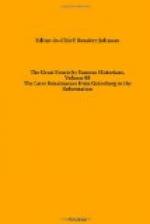On Thursday, September 27th, they saw another alcatras coming from the westward and flying toward the east, and great numbers of fish were seen with gilt backs, one of which they struck with a harpoon. A rabo-de-junco likewise flew past; the currents for some of the last days were not so regular as before but changed with the tide, and the weeds were not nearly so abundant.
On Friday, the 28th, all the vessels took some of the fishes with gilt backs; and on Saturday, the 29th, they saw a rabo-de-junco, which, although a sea-fowl, never rests on the waves, but always flies in the air, pursuing the alcatrases. Many of these birds are said to frequent the Cape de Verd Islands. They soon afterward saw two other alcatrases and great numbers of flying-fishes. These last are about a span long, and have two little membranous wings like those of a bat, by means of which they fly about a pike-length high from the water and a musket-shot in length, and sometimes drop upon the ships. In the afternoon of this day they saw abundance of weeds lying in length north and south, and three alcatrases pursued by a rabo-de-junco.
On the morning of Sunday, September 30th, four rabo-de-juncos came to the ship; and from so many of them coming together it was thought the land could not be far distant, especially as four alcatrases followed soon afterward. Great quantities of weeds were seen in a line stretching from west-north-west to east-north-east, and a great number of the fishes which are called emperadores, which have a very hard skin and are not fit to eat. Though the admiral paid every attention to these indications, he never neglected those in the heavens, and carefully observed the course of the stars. He was now greatly surprised to notice at this time that Charles’ Wain, or the Ursa Major constellation, appeared at night in the west, and was north-east in the morning. He thence concluded that their whole night’s course was only nine hours, or so many parts in twenty four of a great circle; and this he observed to be the case regularly every night. It was likewise noticed that the compass varied a whole point to the northwest at nightfall, and came due north every morning at daybreak. As this unheard-of circumstance confounded and perplexed the pilots, who apprehended danger in these strange regions and at such unusual distance from home, the admiral endeavored to calm their fears by assigning a cause for this wonderful phenomenon. He alleged that it was occasioned by the polar star making a circuit round the pole, by which they were not a little satisfied.




